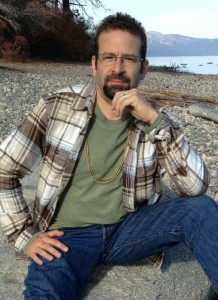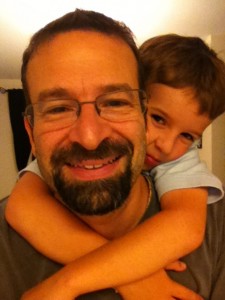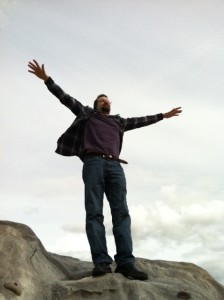 Are you seeking enlightenment? What I’m about to say may be surprising: give up this search for enlightenment. Everyone seeking “enlightenment” ensures only one result, the continuation of his or her own unhappiness. Your fundamental interest is best served by simply dumping this search for enlightenment into the nearest trashcan.
Are you seeking enlightenment? What I’m about to say may be surprising: give up this search for enlightenment. Everyone seeking “enlightenment” ensures only one result, the continuation of his or her own unhappiness. Your fundamental interest is best served by simply dumping this search for enlightenment into the nearest trashcan.
In the present essay, I would like to deconstruct or demythologize “enlightenment” and explain the central insight of Non-Duality within many of the Hindu and Buddhist traditions. This central insight may be concisely stated as follows: you are already awake, and nothing can make you more awake than you already are. As something not already in your possession, not already your present reality, and therefore as something you aim to attain, enlightenment is a myth, indeed a delusion. The search for enlightenment is self-defeating in this way, for the reality you are seeking can never become your present reality because it already is your present reality. As Zen Buddhist Sekkei Harada has said, “If you make a separation between yourself and what you are looking for, no matter how much effort you make to lessen that distance, that effort will be in vain.”
I. The Enlightenment-Seeking Game
Humans have something of a shared project: the search for completion, satisfaction, or fulfillment. In the material sphere of existence, we seek completion through money, fame, physical possessions of various sorts, drugs, and—if we’re more “evolved”—the right kind of relationship with another person (e.g., friendship, lover, partner). Many people realize at some point, though, that none of these objects or relationships really brings a genuine or lasting completion or fulfillment. Once we’ve run through multiple unsatisfying relationships or career paths, we may find ourselves, like many others, moving on and seeking completion in an ostensibly transcendent or spiritual object or relationship. By way of meditation, prayer, or some other spiritual practice, one seeks spiritual awakening or a personal connection with God. Those lucky enough to find it, inevitably lose it and spend the rest of their lives trying to find it again.
Why?
The search for completion, whether undertaken in the material or spiritual spheres of human experience, is actually one and the same. It’s the search to be someone or something, to have an identity, and it’s rooted in our shared sense of incompletion and lack of satisfaction. At the root of the search for enlightenment is the same feeling and belief at the root of the search for completion in the material sphere of existence, namely the feeling of separateness and the belief that I am a separate self and therefore lacking a connection or oneness with others and the world. From this notion of being a separate self arises all suffering or lack of satisfaction. As long as searching is present, lack of satisfaction is present. As Francis Lucille has aptly noted, “unhappiness is the search for happiness.” What must ultimately be uprooted is not the object of the search, but the very search itself. The reason why our search for enlightenment fails is not because we haven’t found the right object. It fails because we think there is an object, something outside ourselves and something not already present, that will bring the satisfaction we wish to attain.
II. The Dualistic Presuppositions of Enlightenment-Seeking
To hear that the search for enlightenment is misguided is initially confusing to most people. This is probably because the eastern spiritual traditions are often portrayed as proposing paths that allegedly lead to enlightenment. Enlightenment is the spiritual equivalent of baking a cake: just follow the recipe, and there are lots of recipes out there for enlightenment. So, for example, by practicing meditation a person is supposed to achieve enlightenment, or by engaging in devotion to a particular god (e.g., Shiva or Krishna) a person is supposed to experience God. After all, wasn’t the “Buddha” (i.e., the “awakened one”) born only when Siddhartha Gautama achieved special insight while sitting under the Bodhi tree after many years of meditation and rigorous spiritual practice? Didn’t the various Christian saints experience God only after their devotional practice was sufficiently elevated?
The assumption in this common account of enlightenment is that we move from lacking something (e.g., knowledge, wisdom, enlightenment, connection with God) to possessing it. Our natural condition, or at least starting point, is that of ignorance: ignorance about the true nature of the world and the self. By following a particular path or spiritual practice this condition of ignorance is supposed to dissolve. One achieves a new condition of awakening or enlightenment. There is practice, and there is the goal to which it leads. Practice and goal are two separate things, and the goal is achieved as the effect of the practice as cause.
This common understanding of enlightenment and its conditions is misleading at best, and in at least one sense simply false. So I call it the “myth of enlightenment.”
The common understanding rests on the false assumption that there is actually a separation between things, for example, between some goal and the means that leads to it, or a separation between the place you’re in at present and where you should be in order to be “OK.” Most fundamentally, it assumes a separation between what you are and that which you wish to attain. The eastern traditions use the word “samsara” to refer to the cycle of death and rebirth, a cycle fueled by our attachments to sense objects (e.g., things, people, relationships). In samsara there is suffering, as our attachments never bring us lasting satisfaction. Samsara is often contrasted with moksha (liberation from the suffering intrinsic to samsara) or nirvana (cessation of the suffering intrinsic to samsara). The common understanding of enlightenment suggests a separation between samsara and moksha/nirvana.
The common understanding engenders questions like, where is Nirvana located? What kind of existence is Nirvana? Do we need to die to get there? Similarly, it leads seekers to suppose that enlightenment is some exotic experience, some altered state of consciousness. After all, if enlightenment is a realm outside of ordinary experience, it must at the very least involve a radically altered state of consciousness. So people end up ingesting some hallucinogenic drug and spending four hours looking at smashed cherries on the sidewalk in the hope of seeing the face of God.
III. The Non-Dual Understanding of Enlightenment
In the non-dual spiritual traditions (for example, in Zen Buddhism and Hindu Advaita Vedanta), the forms of separation or duality suggested by the common understanding of enlightenment are considered false, or at any rate they cannot be the ultimate truth. Therefore, non-dual traditions have a very different understanding of enlightenment and its relation to spiritual practice and our present condition.
Three famous non-dual teachers illustrate the fundamental point.
Second-century Indian philosopher Nagarjuna wrote:
Nothing of saṁsāra is different from nirvāṇa, nothing of nirvāṇa is different from saṁsāra. That which is the limit of nirvāṇa is also the limit of saṁsāra; there is not the slightest difference between the two.
Zen master Dogen said:
You should understand that birth-and-death is itself nirvana. Nirvana is not realized outside of birth-and-death. . . . Between aspiration, practice, enlightenment, and nirvana, there is not a moment’s gap. . . .It’s not that there is no practice and no enlightenment. It’s just that it’s not possible to divide them.
Ramana Maharshi taught:
The state of Self-realization, as we call it, is not attaining something new or reaching some goal which is far away, but simply being that which you always are and which you always have been.
It is false to speak of realization. What is there to realize? The real is as it is always. We are not creating anything new or achieving something which we did not have before. . . . Liberation is our very nature. We are that!
There is no goal to be reached. There is nothing to be attained. You are the Self. You exist always. Nothing more can be predicated of the Self than that it exists. Seeing God or the Self is only being the Self or yourself. Seeing is being.
So where is nirvana? Answer: it’s nowhere; indeed, it’s nothing other than life as it is already present to you. What kind of experience is it? Answer: it isn’t an experience at all. It’s what is present in all experience, namely the awareness or consciousness at the root of every thought, feeling, and sensation, or what is often called the witnessing background of experience. As Maharshi repeatedly said, nothing is more evident to us than I am, not I am “this” or “that,” but simply I am, simple consciousness, or the abiding presence of awareness.
According to the logic of Non-Duality, there can be no ultimate separation between practice and enlightenment because reality as such is non-dual. Since the mind operates according to dualistic categories, the mind’s grasp of reality is always by means of conceptual and categorical overlay. We cannot say that the mind is grasping things as they truly are. Consequently, practice and enlightenment become two things by way of mental engagement with reality as it is. Similarly, no one can achieve enlightenment or awakening because that which is (inadequately) signified by the term “awakening” is already the present reality, indeed the only reality there is.
In considering your alleged “awakening,” simply ask yourself “who is there to be awakened”? Not your true Self, for your true Self is already awake, just as the sun is already shining and inseparable from its light. The mind cannot be awakened, for to become awake is to see and be all things as they truly are, as ultimately one. This is beyond the mind, which can only approach it by speculative and theoretical reconstruction, as an object of inquiry. A character in a film may intellectually entertain the possibility of being made out of the screen, but he cannot experientially know it. Similarly, the mind cannot know the substratum of pure awareness out of which it is made.
What is often obscured in this exploration is the distinction between the fact of our essential nature and the mind’s encounter with it or approach to it. Our essential nature is clear seeing or simple awareness. More completely stated, it’s the union of being and knowing, and peace is intrinsic to it. For this reason, in Vedanta the Self is called satchitananda (being-consciousness-bliss). Hence, peace is already the present reality. However, having judged this reality not to be present, the mind embarks upon the search for it. Of course, it will not find it for the very reason that it initially judges it absent. The present reality eludes the grasp of the mind because reality is non-dual, but the mind operates on a dualistic schema, which filters and alters the present reality, dividing it into subject-object and thereby separating being and knowing. Hence, the peace intrinsic to our very Self is not graspable by the mind. At best, it’s obscurely reflected in the mind it in a filtered, limited form.
A frequently used analogy to illustrate the relationship between the mind and our essential nature as abiding peaceful awareness is that of a dusty mirror that reflects rays of light from the sun. The mirror can only inadequately approximate the reality of the sun by reflecting its light along the surface of its limited, dusty contours. Neither the mirror nor the light it reflects is the sun itself. It’s the sun altered or modified in the form light from the mirror. Similarly, the effects of our essential nature may arise in the mind, veiled and altered under name and form. In this way, “awareness” – I am – takes the form of a particular I-thought (I am a man, I am a student), I-feeling (I am tired, I am sad), or I-sensation (I am appeared to redly, I am appeared to mountainly). The latter are all limited names and forms of unlimited awareness. At best they dimly reflect our essential nature.
Rupert Spira has nicely summarized enlightenment from the non-dual viewpoint.
Real enlightenment is not an exotic experience. It’s the natural condition of all experience. It’s the most familiar thing we know: just the knowing of our own being as it is, and it shines at the heart of all experience.
IV. Re-Conceptualizing the Enlightenment Experience
What then is the alleged experience of enlightenment? After all, many people have claimed such an experience. Two possibilities present themselves that are consistent with non-duality.
First, they may be referring to the mind’s reflection of the reality that is already present as their essential Self. Here there is no becoming enlightened. The mind is always reflecting this present reality, for it is not an experience but the witnessing background of all experience. What is always present is awareness, I am or I am present. At the most we can say that something is noticed, in much the same way that we may suddenly notice the screen on the television we’ve been watching for an hour. We’ve been looking at the screen all along as we watch the movie. But our attention shifts to the screen as that out of which the movie is made. Periodically there is a blissful experience or some other apparent shift in awareness. The thing to understand here is that the particular experience is an effect of the deeper reality; it is not that reality itself. Those who are seeking a particular experience will invariably miss their essential nature.
Alternatively, what is called “enlightenment” may also be conceptualized not as an event in the mind or ego (even as the effect of our essential Self), but as what is left when the separate self or mind has dissolved. This preserves non-duality in a more coherent manner. When there is a noticing of abiding awareness, it’s the same noticing that is happening all along, except that the hindrance, the mind, has been removed. The mind does not apprehend the Self, neither directly nor indirectly. It is knowing that knows, and knowing immediately and infallibly knows itself. And this knowing is simply non-different from being the Self each person essentially is, in much the same way that the sun’s being just is the sun’s illumination.
We can, of course, interpret spiritual practice in either of these two ways, as either a polishing of the mirror or as a shattering of the mirror. But consider practice from the latter viewpoint. Ramana Maharshi, in recommending the method of self-inquiry, asked his students to trace the I-thought back to its source, which is the Self or Essential I of pure awareness. In this process, of course, the mind never gets to the source. It dissolves upon approach, like rays of light reflected off a mirror back into the sun from which they originated. As Maharshi said, “When the ‘I’ is divested of the ‘I’ only the ‘I’ remains.” So it’s not that the mind achieves insight, either directly or indirectly. The mind simply ceases to exist. It’s not that practice polishes the mirror. Practice breaks the mirror altogether, which is why the understanding that is present in clear seeing is non-different from our very being. Better yet, practice is the celebration of realization as our essential nature.
Hence, Maharshi says:
You are awareness. Awareness is another name for you. Since you are awareness there is no need to attain or cultivate it. All that you have to do is to give up being aware of other things, that is of the not-Self. If one gives up being aware of them then pure awareness alone remains, and that is the Self.
V. A Non-Dual Orientation Towards Practice
We can still speak of enlightenment or awakening, though paradoxically there is no one there to be enlightened or awakened. At the most, we can say there is awakening. Indeed, there was awakening, there is awakening, and there will always be awakening. There is also no need to deny practice. What is essential is the attitude towards it. Any orientation towards practice that loses sight of the abiding presence of awareness loses sight of practice itself, for practice is itself an expression of the awakening that is the Self.
Paradoxically, the best practice for a person will be whatever practice helps relax and dissolve the effort to find enlightenment. It can be playing the guitar, basketball, writing in a journal, sitting by the ocean, reading a book, petting a cat, making love, eating chocolate, painting a wall, or sitting in a Zendo with your face to the wall. All these activities can be forms and expressions of meditation, if by this we understand what Krishnamurti said: “in meditation every form of search must come to an end.” What is crucial is being present, and you are utterly present whenever your activity is undertaken for no reason other than the pure love of doing it. Here you see that meditation is what you are, and it’s merely revealed in the practice. For this reason, Jeff Foster says, “the end of all seeking is life as it is.” Here there is clear seeing, of dogs, people, trees, rivers, butterflies, birth, pain, and death.
Of course, life “as it is” is already underway and totally present. Oneness is not something separate from what is already happening around you and within you. And you are already seeing life as it is. Indeed, you are that life! Therefore, in your essential nature you are already awake, and nothing can make you more awake than you already are.
Michael Sudduth


 Follow
Follow




